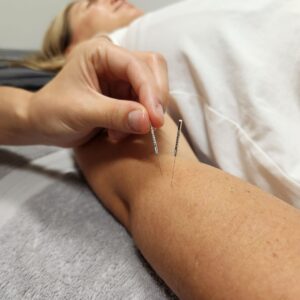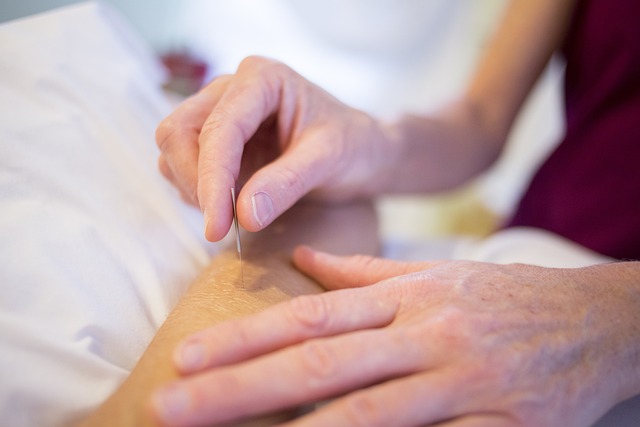Enhancing clinical practice with dry needle acupuncture in Perth
Dry needling, often known as trigger point dry needling, is an invasive procedure performed by physical therapists to treat various musculoskeletal conditions. It shares similarities with acupuncture, using acupuncture needles to stimulate trigger points and acupuncture points. This technique has gained significant attention within the field of physical therapy and has been a subject of interest among practitioners and patients alike.
Exploring the benefits of dry needling. A comprehensive guide
One of the primary focuses of dry needling is the treatment of myofascial pain, particularly in conditions like low back pain. Research supports that dry needling improves pain control and normalizes biochemical and electrical dysfunction of motor points and trigger points. It has also been shown to have a positive impact on myofascial trigger point pain.

While dry needling and acupuncture share the use of acupuncture needles, they differ in their underlying principles. Acupuncture is rooted in traditional Chinese medicine and focuses on the flow of energy, or qi, within the body. In contrast, dry needling is based on Western medical principles, targeting specific trigger points to relieve pain and dysfunction.
Physical therapists who perform dry needling must undergo specialized training to ensure the safe and effective use of this technique. The American Physical Therapy Association and the Physical Therapy Board of Examiners oversee the practice of dry needling to ensure that it falls within the scope of physical therapy.
Dry needling can be used in conjunction with other therapeutic modalities, such as manipulative therapy or electrical dry needling. Additionally, it can be utilized as part of a comprehensive treatment plan for conditions like plantar heel pain, often achieving positive outcomes.
Patients with musculoskeletal pain may be interested in dry needling as a treatment option. It is essential to consult with a qualified physical therapist to determine whether dry needling alone or in combination with other therapies is appropriate for one’s specific condition.
Research supports that dry needling improves pain control, enhances the reliability of physical examination findings, and offers a viable treatment option for a range of musculoskeletal conditions. Whether used in dry needling practice or as part of a broader treatment plan, it is within the scope of physical therapists to perform dry needling, ensuring that patients receive the best possible care for their pain and dysfunction.
Contradictions and Considerations for Dry Needling in Physical Therapy
Dry needling is a technique that involves the insertion of thin needles into the skin to stimulate trigger points, similar to acupuncture. While both dry needling and acupuncture share the use of needles, there are notable differences between the two practices.
Traditional acupuncture, rooted in ancient Chinese medicine, focuses on the flow of energy or “qi” along meridians in the body. Acupuncture aims to restore balance and alleviate various health conditions by inserting needles into specific points along these meridians. Western medical acupuncture, also known as medical acupuncture, incorporates a more anatomical and physiological approach, aligning with the principles of modern medicine.

However, contradictions and considerations surround the use of dry needling. The practice of dry needling is within the scope of many physical therapists, but it requires specialized training and certification. The Board of Physical Therapy Examiners governs the use of direct dry needling by physical therapists. Some argue that the term “dry needling” should be reserved for physical therapy practice, distinguishing it from traditional acupuncture.
One of the main contrasts between acupuncture and dry needling is the underlying philosophy. Acupuncture follows traditional Chinese medicine principles, while dry needling primarily focuses on the neuromuscular system. The effects of dry needling are often attributed to local mechanical and neurological responses rather than the flow of qi. Dry needling has been shown to be particularly effective for conditions like plantar heel pain and trigger points.
In practice, the choice between dry needling and acupuncture depends on the patient’s condition and the practitioner’s expertise. Some patients may benefit from a combination of both approaches, where acupuncture is used for reducing pain and improving energy flow, while dry needling targets specific musculoskeletal issues. Manual physical therapy is another valuable complement to these treatments, providing holistic care for patients.
Dry needling and acupuncture are distinct but related therapies that utilize needle insertion to achieve therapeutic effects. The effectiveness of each depends on the condition being treated and the practitioner’s skill. While dry needling has gained recognition within the field of physical therapy, it’s essential to consider the scope of practice and training requirements. Patients seeking treatment for knee pain or other musculoskeletal issues should consult with a qualified practitioner to determine the most appropriate approach.
Superficial Dry Needling vs. Non-Trigger Point Dry Needling. Understanding the Differences
Dry needling is a versatile technique used in various contexts, but it’s often confused with acupuncture treatment. To clarify, let’s delve into the distinctions between different dry needling techniques and acupuncture.
Dry needling, as the name suggests, involves inserting a thin needle into the skin. While it shares this commonality with acupuncture, the purposes and methods of dry needling versus acupuncture treatment differ significantly.
One primary differentiation lies in the target points. Acupuncture follows traditional Chinese acupuncture points, aiming to restore the body’s energy flow. In contrast, dry needling defines trigger points in muscles, typically associated with pain and muscle dysfunction. This is known as non-trigger point dry needling.
Superficial dry needling, on the other hand, involves needling just beneath the skin’s surface and does not target trigger points. This technique is used to stimulate the superficial tissues, such as skin and fascia, to elicit a therapeutic effect.
Another distinction is the effect of acupuncture versus dry needling on the spinal cord. Acupuncture is believed to influence the spinal cord and nervous system to reduce pain and promote healing. Dry needling primarily targets muscles and their associated nerves.
Electrical dry needling is a specialized form of this technique. It involves applying electrical stimulation to needles during a dry needling session, enhancing its therapeutic potential. This is different from traditional acupuncture, which doesn’t involve electrical stimulation.
For specific conditions like plantar heel pain, dry needling for plantar heel pain is preferred. This technique directly targets trigger points in the foot muscles, offering relief to those suffering from this ailment.
Wet needling is another variation, where substances like saline or anesthetic solutions are injected through the needles. This approach is distinct from both dry needling and acupuncture.
The choice between dry needling or acupuncture depends on the condition being treated and the practitioner’s approach. Acupuncture, a traditional form of acupuncture treatment, has a long history of use and is often chosen for its holistic approach to health and wellness.
In contrast, dry needling, especially trigger point dry needling, is highly focused on musculoskeletal issues and is favored in cases where muscular dysfunction or pain is the primary concern. It’s commonly utilized in physical therapy and sports medicine.
The effectiveness of acupuncture is well-established in reducing pain and improving overall health. Dry needling, though a relatively newer practice, is gaining recognition for its role in managing musculoskeletal conditions.
While both dry needling and acupuncture involve needles, their target points, goals, and methods differ significantly. Acupuncture is a holistic form of treatment based on the principles of traditional Chinese medicine, while dry needling focuses on trigger points in muscles and has a more musculoskeletal orientation. The choice between these techniques depends on the specific condition and the practitioner’s approach.
Dry Needling Targets and Its Role in Physical Therapy
Dry needling is a specialized technique that has gained popularity in the field of physical therapy. It involves the use of thin needles that are inserted into the skin and underlying tissues at specific points on the body. Unlike the practice of acupuncture, which follows a different philosophy and targets energy meridians, dry needling defines a more anatomically based approach.
In the management of various musculoskeletal conditions, physical therapists utilize dry needling as a valuable tool. The needles used in this technique are not injected with any substance but are instead inserted into trigger points, knots in muscles, or tight bands of tissue to stimulate a healing response. This is particularly effective for reducing pain and improving muscle function.
One variation of dry needling is electrical dry needling, where a mild electrical current is applied to the needles once they are inserted into the skin. This can further enhance the therapeutic effects by promoting muscle relaxation and blood flow to the targeted area.

Dry needling is a technique used in physical therapy for the management of musculoskeletal conditions. It involves the insertion of thin needles into specific points on the body, without injecting any substances. Unlike acupuncture, which follows a different philosophy, dry needling is based on anatomical principles. It can be highly effective in reducing pain and improving muscle function, and it is a valuable tool in the arsenal of physical therapists.
Acupuncture for Osteoarthritis vs. Dry Needling. A comparative analysis
Osteoarthritis is a common degenerative joint condition that affects millions of people worldwide, causing pain and decreased mobility. Two alternative therapies that have gained attention in managing osteoarthritis symptoms are acupuncture and dry needling. While both involve the insertion of thin needles into specific points on the body, they differ in their techniques, underlying principles, and effectiveness.
Acupuncture, rooted in traditional Chinese medicine, has been practiced for thousands of years. It focuses on stimulating specific points along energy pathways, known as meridians, to restore balance in the body. Acupuncture for osteoarthritis aims to reduce pain, inflammation, and improve joint function. Several studies have shown promising results in pain reduction and improved quality of life for osteoarthritis patients who receive acupuncture treatments.
Dry needling, on the other hand, is a more recent therapeutic technique, often performed by physical therapists or healthcare professionals. It targets trigger points or myofascial knots in muscles, aiming to release tension and alleviate pain. While it is not based on traditional Chinese medicine principles, dry needling has gained popularity for its potential to reduce muscle tightness and improve range of motion in osteoarthritis-affected joints.
Comparing these two therapies reveals several key differences:
Philosophical Basis: Acupuncture is based on traditional Chinese medicine’s holistic approach, emphasizing the flow of energy (Qi) throughout the body. Dry needling, however, is rooted in Western medicine principles, focusing on the musculoskeletal system and neuromuscular connections.
Needle Placement: Acupuncture practitioners follow precise meridian points for needle placement, which may not necessarily correspond to the site of pain. In dry needling, needles are inserted directly into muscle trigger points or areas of pain.
Treatment Duration: Acupuncture sessions are often longer, involving a comprehensive assessment of the patient’s overall health and may require multiple sessions over an extended period. Dry needling sessions are usually shorter and may require fewer visits.
Pain Reduction: Both therapies have shown potential for pain reduction, but the mechanisms behind their effectiveness differ. Acupuncture may work by modulating pain signals and promoting natural pain-relieving substances in the body. Dry needling primarily addresses localized muscle tension and pain.
Research Evidence: Acupuncture has been studied more extensively for osteoarthritis, with several clinical trials demonstrating its effectiveness. Dry needling research is still evolving, and more studies are needed to establish its long-term benefits for osteoarthritis patients.
In summary, acupuncture and dry needling offer distinct approaches to managing osteoarthritis symptoms. Acupuncture, with its traditional roots and comprehensive approach, may be suitable for individuals seeking a holistic healing experience. Dry needling, with its focus on localized muscle tension and pain relief, may be preferred by those looking for a more targeted treatment.
Get to know us at deep tissue massage !



